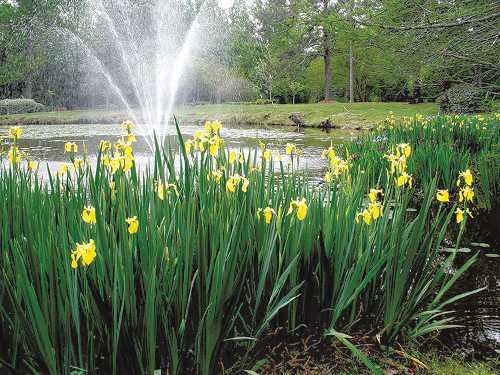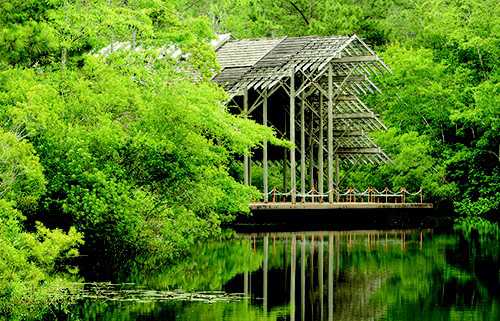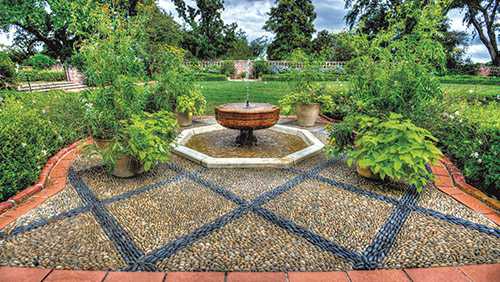
Photo by Dr. Chris Werner
Daffodil Valley at Afton Villa Gardens
Cherry trees in the Daffodil Valley at Afton Villa Gardens are lovely reminders of the Japanese-American Imahara family gardeners who planted them circa 1950.
Afton Villa Gardens
Just beyond a wrought iron gate adorned with fuchsia and coral azaleas lie 250 acres of lush foliage amid remnants of a villa that was once the most grandiose house in West Feliciana Parish. Had it not burned to the ground fifty-three years ago, the walls of Afton Villa would have many a story to tell. All that remains today, however, are the majestic gardens and hints of the fine home that once stood among them.
The story of Afton Villa Gardens is one that goes back nearly two hundred years. In 1820, Bartholomew Barrow purchased 867 acres of land that included a plantation home, which he then sold to his son, David, who called the property The Home Place. David’s second wife was responsible for turning the modest house and property into Afton Villa, the most imposing Victorian Gothic-style home in the parish.
Unfortunately, the villa burned to the ground in 1963, leaving much of the property to run wild for nearly a decade. Horrified at the neglect, Genevieve Trimble and her husband bought the property in 1972 and began restoring the garden to its original splendor. “I always thought it was one of the most romantic places I’ve ever seen,” said Trimble.
Their hard work can be appreciated while driving between the winding oaks and blossoming flowers that lead to the ruins of the historic villa. Each spring, eight thousand tulips are planted on the property, with Trimble choosing the variety each year. There is also an array of yellow daffodils from Amsterdam that are planted each March. The large red Pride of Afton azalea, just beyond the guardhouse, is exclusive to Afton Villa and worth seeing.
LSU Press has just published Afton Villa: The Birth and Rebirth of a Nineteenth-Century Louisiana Garden. The 120-page book by Genevieve Trimble features sixty-seven color photos and a comprehensive history of the home. It will be available in stores this month.
Beginning March 1, visitors can explore Afton Villa Gardens in person: Daffodil Valley, the Music Room, the Ruins Garden, the Grand Staircase, a parterre, a pond, a marble obelisk, and a cemetery where David and Bartholomew Barrow and their families are laid to rest.
9047 Highway 61
St. Francisville, La.
(225) 721-2269 • aftonvilla.com
Spring: March 1—July 1
Fall: October 1—December 1
Photo by K. Ed Norred, Horticulture Manager, Park Operations, Cohn Arboretum.
BREC'S Cohn Arboretum
Just over ninety years ago, Alphonse deBretton gave his daughter and her husband sixteen acres of heavily wooded land just north of Baton Rouge on what is now Foster Road. The Cohns built a house on the land for $748 and developed the remaining land into a sanctuary for more than one hundred plant species. In 1964, the Cohn family donated the land to BREC and it became the Cohn Arboretum. The property is now home to more than three hundred species of flora and fauna and is devoted to the preservation and study of native plants and animals.
Cohn Arboretum Horticulture Manager Ed Norred said that March and April are the best months to visit the preserve. “Spring is my favorite time of year at Cohn,” said Norred. “It is a celebration of life, from the beautiful flora, the baby ducks in the pond, and the migrating water fowl to the singing of birds and playfulness of the squirrels and chipmunks.”
Silverbells, parsley hawthorne, azaleas, redbuds, Japanese magnolias and a thirty-year-old Japanese maple will all be at their height this month. Additionally, many bulbs will be blooming beneath the verdant spring green of the tree canopy. The Louisiana irises are “show stoppers,” said Norred.
A walk through Cohn Arboretum will take visitors through a bamboo forest, a tropical conservation greenhouse, a vegetable and herb garden, and an exhibit of various shrubs and trees such as camellias, crape myrtles, roses, magnolias, hollies, and evergreens. For the kid in all of us, there is a butterfly garden as well.
Visitors can walk around the 0.8-mile paved trail circling the lake; another path winds through a wooded area.
12206 Foster Road
Baton Rouge, La.
(225) 775-1006 • brec.org
Hours: Guided tours are available by appointment. Otherwise, open daily from 8 am to 5 pm. Free.
Pinecote Pavilion at Crosby Arboretum. Photo by Lana Gramlich.
Crosby Arboretum
Off of Ridge Road in Picayune, Mississippi, is a seven hundred-acre nature preserve home to more than three hundred species of indigenous trees, shrubs, and wildflowers along with rare, threatened, or endangered species of plants and wildlife. The mission of Crosby Arboretum, part of Mississippi State University’s Coastal Research and Extension Center, is to preserve, protect, and display plants that are native to the Pearl River Drainage Basin ecosystem.
The arboretum was established as a living memorial to prominent forestry figure and philanthropist L.O. Crosby, Jr. and was opened to the public in 1986. It wasn’t until 1997 that the arboretum became part of MSU. The Crosby Arboretum serves as an ecosystem to be studied for botanical research as well as offer cultural, scientific, and recreational programs. “A lot of landscape architect students help plan the exhibits, and we have architecture students who build the bridges,” said Pat Drackett, director of the arboretum.
The acreage is divided into seven natural areas, with the 104-acre Native Plant Center serving as the focal point. This center includes the Pinecote Pavilion and Piney Woods Lake. The pavilion is an all-wood structure built from indigenous materials and native pine fastened together with nails, dowels, and metal connections. All of the wood and metal is painted to complement the earth and plants, which is also why the wood shingles mimic tree bark and bird wings. There are also many wooden bridges in the lake area that were designed by award-winning architect Fay Jones of Fayetteville, Arkansas.
The arboretum exhibits three basic habitats found in the Pearl River Drainage Basin ecosystem: savanna, woodland, and aquatic. Within these habitats, visitors can see various blooms depending on the month. In March, look for red maple trees that produce crimson-to-pink flowers, mayhaws with dark pink flower buds, dogwoods with white flowers, Elliott’s blueberry, wax myrtles, yellow jessamine, and white and purple sunbonnets. “March is the perfect time for native blooms,” said Drackett.
Blooms in April include the yellow pitcherplant, found around the bogs; yellow star grass; daisies; wild black cherry; red chokeberry; star anise; wild azaleas; and Louisiana irises that ring Beaver Pond. On April 3, the arboretum will host its annual Strawberries & Cream Festival to commemorate the strawberry fields that once occupied the land on which the arboretum now sits. Free strawberries and ice cream will be served at the festival from 1 pm to 3 pm, with an art show to boot.
370 Ridge Road
Picayune, Miss.
Hours: Wed–Sun, 9 am–5 pm. Tours are self-guided, though staff-guided tours are available upon request.
crosbyarboretum.msstate.edu
Detail of the stonework at Longue Vue. Photo by Ryan Lips.
Longue Vue House & Gardens
In 1939, New Orleans philanthropists Edgar and Edith Stern commissioned a twenty-room house which would allow Edith a view of the garden from every window in every room of the house. The small house that was once encircled by the many beautiful gardens at 7 Bamboo Road was transplanted down the road while the much larger Longue Vue House was constructed. The grand three-story house that stands there today draws in hundreds of visitors each spring to learn of the home’s history and explore its surrounding gardens.
One of the last Country Place era homes built in the U.S., Longue Vue is surrounded by fourteen elaborate gardens, twenty-two water features, and a goldfish pond. The entrance to Longue Vue begins with a ride down Oak Allée, a short drive lined with old oak trees swaddled in beds of lush liriope. Toward the back of the home is a rectangular lawn, echoing the European gardens of the Country Place era. Here, visitors will find the Canal Garden, a rectangular pool, set off by intricately designed boxwood bushes planted into a small maze.
Once called the Victory Garden, during World War II, Longue Vue’s Walled Garden raises vegetables and herbs that are cultivated by a local group of young men, who then sell the produce at the farmers market, with proceeds donated to their charity of choice. “This garden was created by the Sterns during the war so they could grow their own food instead of buying canned goods that would take away from the soldiers’ supply,” said Longue Vue’s Director of Horticulture Amy Graham.
Longue Vue’s most popular attraction, its Louisiana irises, can be seen in full abundance mid-March through mid-April in the Wild Garden. On March 31, visitors are invited to attend Louisiana Iris Day at Longue Vue, with live music to entertain visitors until 6 pm.
A walk around the eight-acre property takes visitors down the Azalea Walk and through Pan Garden, the East Lawn, Portico Terrace, the Yellow Garden, and the Lucy C. Roussel Interactive Discovery Garden for kids. One can count on spotting petunias, pansies, azaleas, camellias, Confederate jasmine, passion flower, Carolina jasmine, wisteria, buckeyes, dogwoods, and pear and plum trees.
“We also have a lot of wildlife such as the great horned owl,” said Graham.
To learn more about the gardens and history of the home, read Longue Vue House and Gardens: The Architecture, Interiors, and Gardens of New Orleans’ Most Celebrated Estate. All proceeds from the book support educational programming at Longue Vue.
7 Bamboo Road
New Orleans, La.
(504) 488-5488
longuevue.com
Hours: Mon–Sat, 10 am–5 pm; Sun, 1 pm–5 pm




